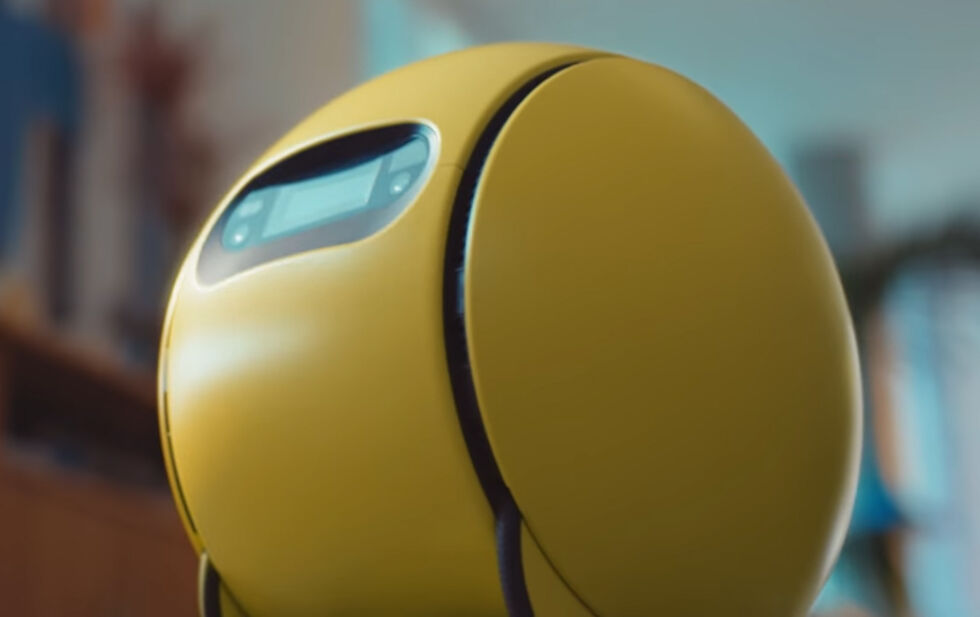-
Ballie is now the size of a bowling ball.
Samsung -
The bigger size lets Ballie pack in a 1080p projector.
Samsung -
Ballie is no longer a totally-spherical ball bot, and instead rolls around on three wheels.
Samsung -
The back has a little track for the back wheel, and what looks like a speaker grille. How exactly does this thing charge, though?
Samsung -
What is this little pop-up top for? It doesn’t make sense for it to be smart home-related. It might be lidar.
Samsung -
A side view of Ballie.
Samsung -
Ballie projecting a TV screen.
Samsung -
It can also project on the ceiling.
Samsung -
Can we talk about Samsung’s depiction of a projector? The black jacket here is darker than the wall it’s projecting on. That’s not possible.
Samsung -
In the bottom right, you can see someone using a mouse and keyboard.
Samsung -
Mirroring a Samsung phone.
Samsung -
There are also side lights.
Samsung
Four years ago at CES 2020, one of Samsung’s quirkier little projects was “Ballie,” a cute little ball robot that would wheel around the house, stream camera footage, and act as a roving smart speaker. The coolest thing about 2020 Ballie was that it would have looked right at home on the set of a Star Wars movie—it was a ball droid, where the wheels were integrated into the spherical body. At CES 2024, Ballie is back with a new design, and according to a report from The Washington Post, it will puportedly hit the market sometime this year. Although much like a concept car being watered down to make it to production, the 2024 Ballie lost much of the prototype’s cute appeal.
The 2024 Ballie is no longer a ball droid, and instead is a sphere mounted on three wheels, giving it basically the same locomotion as a robot vacuum. The new Ballie is also bigger, growing from about the size of a softball to the size of a bowling ball, and it’s now a two-handed lift. This bigger size can give production Ballie a more practical battery size and make room for a projector. It looks like the sides of the sphere body are stationary (that’s where the wheels are mounted), while the sphere’s center can still rotate up or down, allowing Ballie to aim the camera/projector mounted on the front.

Samsung
It looks like there are five sensor windows on Ballie’s front visor. The big center rectangle is the projector, with a camera on the left and right side, giving the bot stereo vision. The other sensors are a mystery. Maybe they are robot navigation sensors like time-of-flight. The back features a lot of openings, which probably include a speaker. A robot vacuum would have visible metal contacts for autonomous docking and charging, but there are no clear ports, connectors, or a dock for charging.
There’s a disc on Ballie’s head that can pop up, and the little hatch is surrounded by a light ring. It’s unclear what this does. Samsung shows it rising while processing a texted smart home command, and it seems to be up or down at various points during the video. It’s hard to imagine a technical reason to have a small part rise up and down like this—an antenna should work fine internally. The feature that would make the most sense to mount in a round protrusion at the top of the robot is lidar, which would be great for navigation purposes. The little hatch does seem to be up any time the robot is rolling around in the video, so that’s our best guess.
The full suite of features appears to be smart-speaker-style voice commands, smart home controls, remote camera access, person recognition, home navigation, and various projector features. Ballie’s projector can be aimed at the floor, wall, or ceiling and display videos and video calls, mirror a Samsung Galaxy phone, or do mouse and keyboard work, which was powered by either a nearby PC or maybe Samsung Dex. The Washington Post says the projector is 1080p, and there’s enough battery for “two to three hours of continued projector use.”
Small home projectors are always a tough sell because they aren’t very bright and can only work in dim lighting. I’m not sure there has ever been a successful consumer projector product outside of pitch-black home theater setups, though there have been a lot of failures. The video did a good job of being somewhat realistic here, showing Ballie’s owners doing projector-based exercising in the dark, having a video call in the dark, and doing some kind of mouse-and-keyboard work in the dark, but those are all very strange things to do in the dark. The video didn’t do a great job with a realistic depiction of what a projected image looks like, though, and many times, it shows Ballie projecting darker colors than the surrounding projection surface, which a light bulb can’t do! Projectors can only make things lighter, not darker.
Samsung’s presentation ended with the plea to “bring home your new companion.” The Washington Post interviewed Kang-il Chung, Samsung’s VP and head of the company’s Future Planning group, who said, “With the way things are progressing, I don’t see any big issue with reaching our goal of releasing it within this year.” If it’s released to consumers, Ballie will battle Amazon’s Astro robot in the nascent home robot market, though that $1,600 robot still isn’t generally available.
-
Samsung 2020 Ballie prototype, which was way cuter looking.
-
Yep, it’s a ball.
-
A close-up of the front.
-
Ballie in hand.
-
The ball bot’s butt. I guess that’s a charging port back there.
-
Ballie chasing its owner around onstage.
Listing image by Samsung

